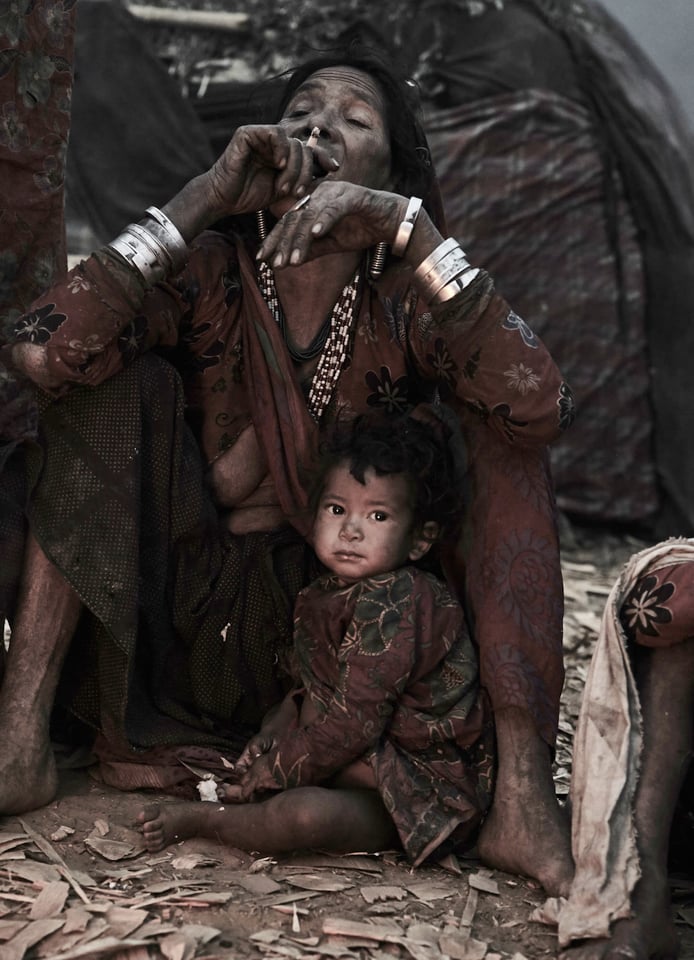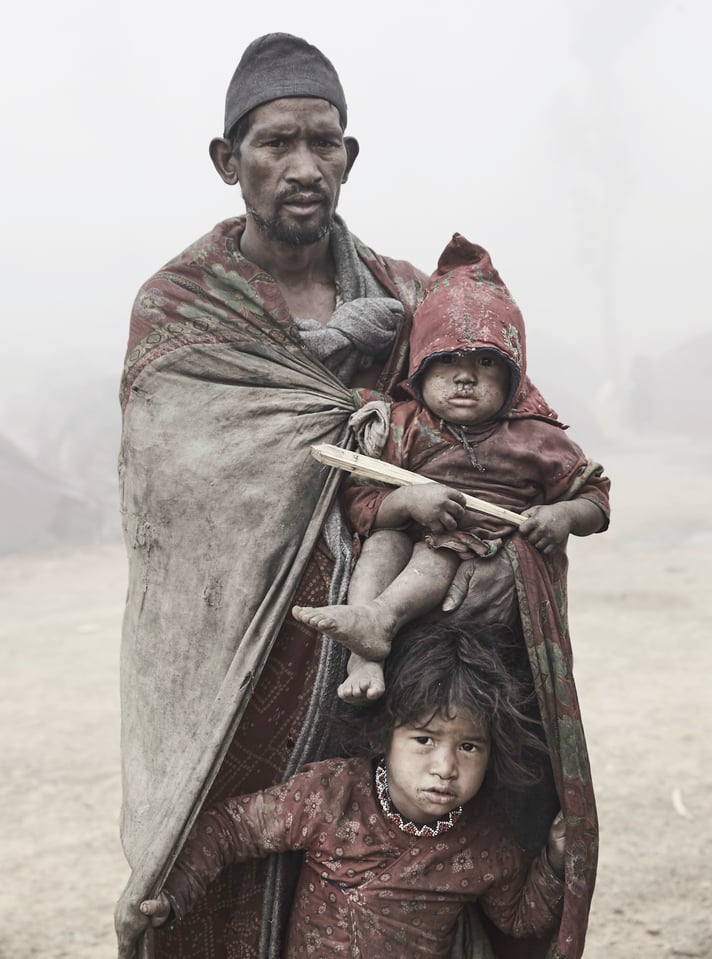The nomadic Rautes are the last hunters-gatherers of the Himalayas. The Rautes, who call themselves Kings of Forests, subsist on langur and macaque monkeys, wild yams, rice and a few kinds of vegetables traded from local farmers. Their main occupation is to trade and exchange of wooden items in nearby villages and bazaars. They migrate from river valleys up to middle hills in the Western parts of Nepal living in temporary camps hidden away from the villages in remote parts of the forests.

Canon EOS-1D X @ 24mm, ISO 4000, 1/250, f/5.0
The nomadic Rautes belong nowhere and everywhere, and they have their own language, culture and beliefs. The Rautes believe in the sun God Berh that represents eternity. The Rautes have managed to avoid forcible assimilation and have not settled in villages and adopted Hindu beliefs and practices. Instead, they continue their traditional life travelling through the forests of Western Nepal.

ILCE-7RM2 @ 155mm, ISO 640, 1/500, f/4.5
The Rautes continue to maintain a certain degree of secrecy and avoidance towards assimilation, in order to keep their identity and to survive as a distinct community. As a photographer and an outsider, it was at first not that easy to deal with the Rautes. It took some days before they understood and accepted me in and around their camp in the forest. First, we had to get the acceptance from the Chief Headman and three other headmen, as well as from the community. Then we could start to hang around and photograph.

Canon EOS-1D X @ 70mm, ISO 2500, 1/160, f/5.0
Several times, the Chief Headman came to the nearby bazaar, where we were staying, for negotiating and making sure that he and the community also benefited from my visit. One of the first days, we had a nice interaction with the Chief Headman and his wife talking about the origin of the Rautes and listening to their stories. We also showed them a book about the Rautes, and it turned out that the person shown on the front page of the book was the father of the Chief Headman’s wife. They were very pleased and happy, and we continued watching a documentary about the Rautes on a laptop. They of course knew all the people in the documentary film. Today, the community counts only 156 people.

Canon EOS-1D X @ 55mm, ISO 2000, 1/250, f/2.8
At some point, the Chief Headman wanted me to buy him and his wife a large rooster. He could not convince me, and we had a bit of crisis later that day. But a few days later, it all worked out very nicely and they got their rooster. Another day, I was taken strongly by the arm and escorted out of the camp. We had not delivered the last goat, as agreed, and we were taken through the forest to the nearby village for goat negotiations. We found a goat at a reasonable price and returned to the camp to continue the photography work.

ILCE-7RM2 @ 95mm, ISO 640, 1/500, f/5.6
The Rautes are very clever people when dealing with local people and outsiders – like a foreign photographer. They have to be, in order to keep their identity and survive, and my visit to the Rautes also resulted in the following expenses:
- 2 x 3 packages of cigarettes
- 2 large packages of suthi (tobacco)
- 2 x 1 kilo of suntalas (oranges)
- 55 pairs of warm topies (caps)
- A big box of biscuits
- One large rooster weighing 5 kilos
- A good contribution for the purchase of five goats

Canon EOS-1D X @ 47mm, ISO 640, 1/320, f/4.5

Canon EOS-1D X @ 24mm, ISO 640, 1/250, f/8.0
It took me three days from the capital Kathmandu to reach the camp of the Rautes in Accham in Western Nepal. When doing such photography, it is very important to stay flexible and willing to spend the necessary time. It is very difficult to plan in great detail beforehand. Expect the unexpected. The uncertainly is what makes it so fascinating. It also all depends on the people you meet. My great advantage was that I know Nepal well and speak the main language Nepali. It meant that I could communicate with the local people and also with some of the Rautes. I had also teamed up with two local journalists, who knew the Rautes well and with a social worker from the area. Local contacts are essential and necessary for such kind of photography.

Canon EOS-1D X @ 33mm, ISO 320, 1/320, f/5.6
I knew that access to electricity would be a problem. I was, however, lucky that we did have access to some solar recharging during some of the days. If you are out in remote areas, you have to think carefully about your battery capacity and possibilities of recharging cameras, laptop, etc. Make sure you have plenty of batteries, reliable storage and solar recharging.

Canon EOS-1D X @ 47mm, ISO 200, 1/125, f/4.5

Canon EOS-1D X @ 70mm, ISO 640, 1/400, f/4.5
Photography is very often about meeting people. In such cases, it is essential to use your empathy and listen to people. Without good interpersonal connections, it would have been extremely difficult to get good portraits. If you decide to photograph remote areas and people like this, it would be very beneficial to do some research beforehand about the people you are going to meet. This will help you when looking for motives, composing your images and develop the story you want to tell. Finally, always be on a lookout for not just portraits, but also environmental shots and details. Such opportunities are everywhere!

Canon EOS-1D X @ 70mm, ISO 200, 1/100, f/11.0

Canon EOS-1D X @ 50mm, ISO 1600, 1/100, f/9.0
I hope you have enjoyed my story about the nomadic Rautes, along with the images presented in this short article.
This article was submitted by Jan Møller Hansen. Please visit Jan’s online gallery to see more of his work.
excellent photos! Thanks a lot!!!!
I love the photos and the story, but not really a fan of the processing. It gives them all a very strong ”look” which they are easily good enough to do without, and its obvious enough that its taking my mind out of the photos and the story and into the processing which is a shame. There’s a few where sharpening halos are creeping in, and the equivalent of what would be the clarity slider in lightroom/camera raw is a touch heavy in some of the backgrounds. I think they would be improved by taking the processing down by 50-70%. I also think they are an excellent set and had great pleasure reading the article.
Thank you, Richard. Much appreciated.
Great story and images. First class !
Thank You.
I love the story and photographs! Excellent work. Thank you for sharing.
It was the first time that I tried my new Sony ILCE 7R Mark II, but I also brought the Canon EOS 1DX – two cameras that supplement each other very well.
Outstanding photos. What programs were used for post processing, and what effects?
I use Capture One Pro 9, DJ – but only do a bit of editing. I am not very good at photoshopping, but is more interested in the motive, composition and story behind the image.
Stunning photographs and narrative . . . Bravo!
Thanks, for letting us learn about them. The pictures are wonderful particularly the second one with the women having her young child in her arms. What also amazed me is the fact they seem to be bare foot in low temperature season.
Great article and great photographs. Thank you!
Looking at these photographs was like looking at a very old copy of National Geographic magazine, when explorers took a cameraman with them, dragging a load of equipment that required a pack mule. And the article was published with a title something like ‘Our Man in Tibet’.
It’s nice to know that not every single corner of the world has been turned into something ‘modern’. I hope it stays that way, and that the Rautes tribe maintains their autonomy. I’d like to know more about them. I hope this brief article is a small part of something else. I enjoyed it very much.
Thank you, Sara, for this interesting comment. I might not be finished with the work……I don’t know yet.